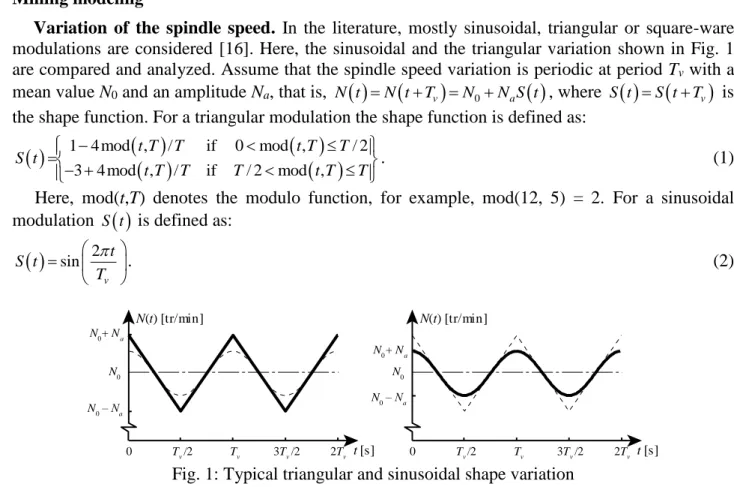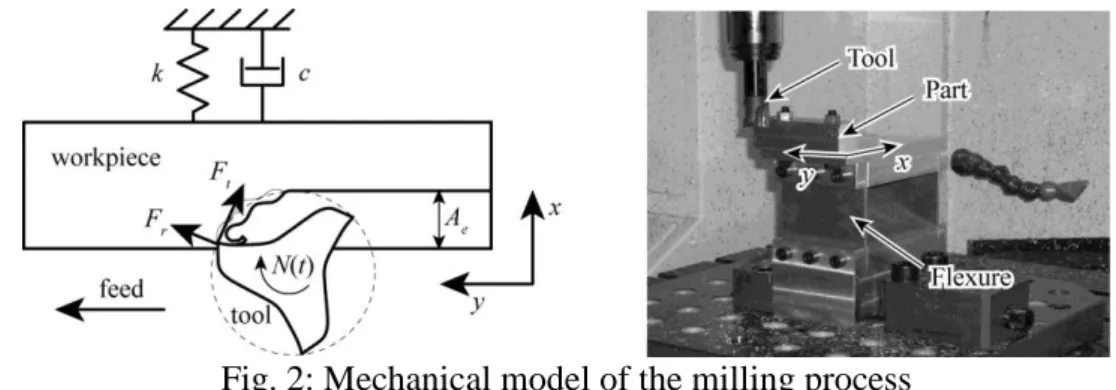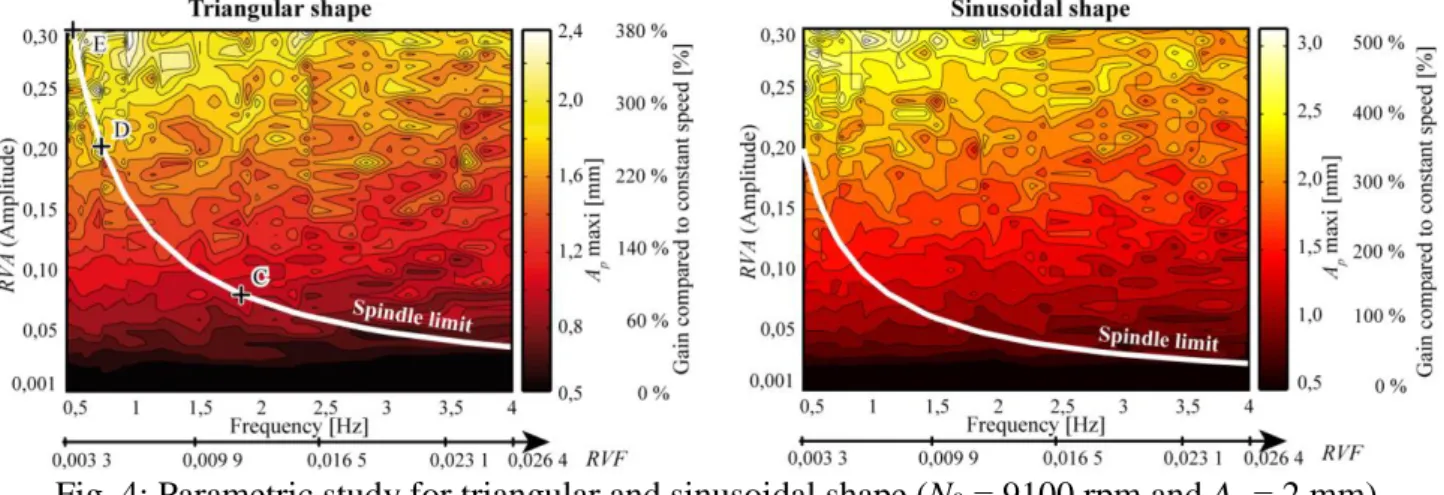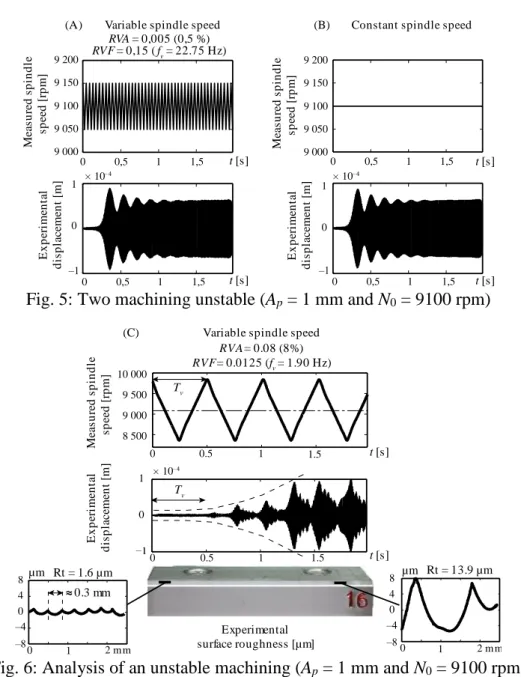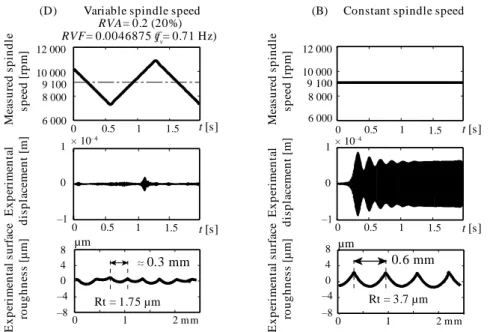HAL Id: hal-01895926
https://hal.insa-toulouse.fr/hal-01895926
Submitted on 23 Nov 2018HAL is a multi-disciplinary open access archive for the deposit and dissemination of sci-entific research documents, whether they are pub-lished or not. The documents may come from teaching and research institutions in France or abroad, or from public or private research centers.
L’archive ouverte pluridisciplinaire HAL, est destinée au dépôt et à la diffusion de documents scientifiques de niveau recherche, publiés ou non, émanant des établissements d’enseignement et de recherche français ou étrangers, des laboratoires publics ou privés.
Control of Chatter by Spindle Speed Variation in
High-Speed Milling
Sébastien Seguy, Gilles Dessein, Lionel Arnaud, Tamás Insperger
To cite this version:
Sébastien Seguy, Gilles Dessein, Lionel Arnaud, Tamás Insperger. Control of Chatter by Spindle Speed Variation in High-Speed Milling. Advanced Materials Research, Trans Tech Publications, 2010, 112, pp.179-186. �10.4028/www.scientific.net/AMR.112.179�. �hal-01895926�
Control of chatter by spindle speed variation in high-speed milling
Sébastien SEGUY
1,a, Gilles DESSEIN
2,b, Lionel ARNAUD
2,c,
Tamás INSPERGER
3,d1 Université de Toulouse, INSA, ICA (Institut Clément Ader), 135 avenue de Rangueil,
F-31077 Toulouse, France.
2 Université de Toulouse, ENI, Laboratoire Génie de Production, 47 avenue d’Azereix, BP 1629,
F-65016 Tarbes Cedex, France.
3 Department of Applied Mechanics, Budapest University of Technology and Economics,
H-1521 Budapest, Hungary.
a sebastien.seguy@insa-toulouse.fr, b gilles.dessein@enit.fr, c lionel.arnaud@enit.fr, d inspi@mm.bme.hu
Keywords: chatter, milling, stability, spindle speed variation, surface roughness.
Abstract. High-speed milling operations are often limited by regenerative vibrations. The aim of
this paper is to analyze the effect of spindle speed variation on machine tool chatter in high-speed milling. The stability analysis of triangular and sinusoidal shape variations is made numerically with the semi-discretization method. Parametric studies show also the influence of the frequency and amplitude variation parameters. This modeling is validated experimentally by variable spindle speed cutting tests with a triangular shape. Stable and unstable tests are analyzed in term of amplitude vibration and surface roughness degradation. This work reveals that stability must be considered at period variation scale. It is also shown that spindle speed variation can be efficiently used to suppress chatter in the flip lobe area.
Introduction
The productivity of cutting processes is severely limited by vibrations that arise during the material removal process. One reason for such vibrations is the surface regeneration. The theory of regenerative machine tool chatter is based on the work of Tobias and Fishwick [1]. This knowledge initially dedicated to the turning process has been adapted to milling [2] and led to the development of the stability lobes theory. Since then several improved model and analysis techniques have been appeared including detailed analysis of the governing delay differential equation and time domain simulations, see, for example [3,4]. These models all use the so-called stability lobe diagrams, which allows to choose the spindle speed associated with the axial depth of cut with a chatter free machining. In many practical cases, the choice of the optimal speed is difficult because contradictory parameters interact with productivity [5].
Another technique to reduce chatter vibrations is the spindle speed variation. As opposed to variable pitch cutters, spindle speed variation can effectively be used in a wider spindle speed range, since the frequency and the amplitude of the speed variation can easily be adjusted in CNC machines even during the machining process. In the 1970's, Takemura et al. [6] presented the first simple model to study the stability of variable speed machining; they predicted significant shift of the stability lobes to higher depth of cuts, but the experimental tests showed only small improvements. Sexton and Stone [7] developed a more realistic model, and they found some improvements in the stability properties for low spindle speeds. Moreover, they showed that the presence of transient vibrations may further reduce these gains.
The study of the stability for variable speed machining requires a special mathematical analysis to compute stability lobes. Tsao et al. [8] have developed a model taking the angular coordinates as variables instead of time. Insperger and Stépán [9] showed that the semi-discretization method can effectively be used for the stability analysis of turning at variable speed. They showed that the critical depths of cut can be increased for low speeds, but for the high-speed domain, no
improvement was found. Recently, Zhang et al. [10] presents a systematic stability analysis of spindle speed variation based on a machining chatter model of non-linear delay differential equation. Experimental results were presented by Al-Regib et al. [11] showing gains on surface roughness for turning at low speed.
The modeling of variable speed milling is more complex than that of turning, since the speed variation frequency and the tooth passing frequency interact and the resulting system is typically quasi-periodic. Still, there are mathematical techniques to determine approximate dynamic properties. Sastry et al. [12] used Fourier expansion and applied the Floquet theory to derive stability lobe diagrams for face milling. They obtained some improvements for low spindle speeds. Recently, Zatarain et al [13] presented a general method in frequency domain to the problem, and show that varying spindle speed can effectively be used to chatter suppression. Another approach is to use time domain simulation [14] that makes it possible to obtain more detailed information like the amplitude of vibrations, the chip thickness or the cutting forces. Simulations were sometimes made at high speed, but to the best knowledge of the authors, experimental validations are only made at low spindle speed [11, 12, 13, 14, 15].
In this paper, the stability of variable speed milling is analyzed in the high-speed domain, for spindle speeds corresponding to the first flip (period doubling). Theoretical stability predictions are obtained using the semi-discretization method based on [4], and the results are confirmed by experiments.
Milling modeling
Variation of the spindle speed. In the literature, mostly sinusoidal, triangular or square-ware
modulations are considered [16]. Here, the sinusoidal and the triangular variation shown in Fig. 1 are compared and analyzed. Assume that the spindle speed variation is periodic at period Tv with a
mean value N0 and an amplitude Na, that is, N t
N t
Tv
N0N S ta
, where S t
S t
Tv
isthe shape function. For a triangular modulation the shape function is defined as:
1 4 mod ,
/ if 0 mod ,
/ 2 3 4 mod , / if / 2 mod , t T T t T T S t t T T T t T T . (1)Here, mod(t,T) denotes the modulo function, for example, mod(12, 5) = 2. For a sinusoidal modulation S t
is defined as:
2 sin v t S t T . (2) N0 Tv/2 Tv 3Tv/2 t [s] N0+ Na N0 – Na 2Tv 0 N(t) [tr/min] N0 Tv/2 Tv 3Tv/2 t [s] N0+ Na N0 – Na 2Tv 0 N(t) [tr/min]Fig. 1: Typical triangular and sinusoidal shape variation
In order to normalize amplitude and frequency variation, the well know, parameters RVA and RVF are introduced: 0 a N RVA N , 0 0 60 60 v v f RVF N T N . (3)
RVA represents the amplitude ratio between the amplitude Na and the mean value N0, it is always
represents a variation of 30% of the spindle speed. This represents also a variation of 30% of the feed by tooth due to the constant feed velocity. RVF is the ratio between the variation frequency fv
and the average spindle frequency N0. It may be higher than 1. If RVF equal to 1, then the spindle
makes one variation period during only one revolution of the tool.
Mechanical model. A schematic diagram of the milling process is shown in Fig. 2. The structure
is assumed to be flexible in the x direction, while the feed is parallel to the y direction.
Fig. 2: Mechanical model of the milling process
The dynamic model is given by the following equation:
x
mx t cx t kx t F t , (4)
where m is the modal mass, c is the damping, k is the stiffness and F tx
is the cutting force in the x direction. According to a linear cutting law, the x component of the force is given by:
1 cos sin z x p R j T j j j F t A K K h t
, (5)where Ap is the axial depth of cut, j is the angular position of the jth cutting edge and KT and KR
are the specific tangential and radial cutting coefficients. The chip thickness is expressed by:
sin
cos
j j z j j
h t g t f x t x t t , (6)
where the function gj
t is a unit function, it is equal to 1 when the tooth j is cutting, otherwise it isequal to 0. Here, fz is the feed per tooth, x t
is the current position of the tool and x t
t
is theposition at the previous cut. The regenerative delay
t is periodic in time due to the spindle speed variation.Stability analysis. Stability of the milling process with variable spindle speed can be estimated
theoretically via the analysis of the governing Eqs. (4), (5) and (6). According to the Floquet theory of delayed differential equations [4], an infinite dimensional operator (monodromy operator) can be associated with the system that gives the connection between the current state of the cutter and the state one period earlier:
x tT x t . (7)
This period T is equal to the principal period of the system. Thus, for the milling model with spindle speed variation, the regenerative time delay and the spindle modulation period Tv are
periodic. We assume that the ratio of the modulation period Tv and the mean time delay is a
rational number, i.e., qTv p with p and q being relative primes. Thus, the system is periodic at the principal period qTvTconsequently, the Floquet theory of periodic DDEs can be applied. Note
that if the ratio of Tv and is not rational, then the system is quasi-periodic and the Floquet theory
cannot be used. Stability properties are described by the eigenvalues of the monodromy operator. If all the characteristic multipliers are in modulus less than 1, then the system is asymptotically stable. Here, the semi-discretization method [4] is used. The basic point of this method is that they provide a finite dimensional matrix approximation of the monodromy operator and the eigenvalues of this
matrix can be determined numerically. This method was validated by time domain simulation [17].
Selection of the optimal parameters
Optimal area. Stability lobe can be constructed by scanning the cutting conditions (spindle
speed and axial depth of cut) for a couple of (RVA, RVF) parameters and for a given shape. Fig. 3 presents the lobes for constant, triangular and sinusoidal spindle speed.
The critical depth of cut can be seen to be increased by speed variation for some ranges of spindle speeds, but for some other ranges, the critical depth of cut is less than that of the constant spindle speed. For example, a cutting process with an axial depth of cut of 1 mm and a spindle speed of 9100 rpm – that is unstable for constant spindle speed – can be stabilized by a speed variation. But globally, the critical depth of cut can be seen to be increased essentially in the area of the first flip lobe by spindle speed variation.
8 000 8 500 9 000 9 500 10 000 0
2 3 4
Mean spindle speedN0 [rpm]
Ap [m m ] 1 Constant speed Triangular speed Sinusoidal speed First flip lobe First Hopf lo be B
Fig. 3: Stability diagrams for variable speed milling with RVA = 0.3 and RVF = 0.003
Comparison of the shape variation. The effectiveness of the spindle speed variation is tested
on a flip lobe area (N0 = 9100 rpm) with a triangular and sinusoidal shape variation.
Fig. 4 shows a contour plot presenting the maximal depth of cut available without chatter for the amplitude (vertical axis) and frequency (horizontal axis) with an average spindle speed of 9100 rpm. At constant speed, the maximal depth of cut is 0.5 mm. It can be seen that the triangular shape always increase the critical depth of cut Ap for any RVA and RVF values. For some domains, even
Ap = 2.4 mm can be achieved that corresponds to 380% improvements. As mentioned earlier, the
choice of the frequency and the amplitude variation is limited by the spindle dynamics. Within the range of variation, the maximum acceleration of the spindle is 100 rev/s2, i.e., 6000 rpm/s.
Considering the limits of the dynamic spindle for the triangular shape, the optimal choice is to use low frequency modulation with high amplitude. Such a point is denoted by point D or E.
Fig. 4: Parametric study for triangular and sinusoidal shape (N0 = 9100 rpm and Ae = 2 mm)
A similar plot is determined for a sinusoidal shape in Fig. 4. Like the triangular shape, the sinusoidal shape always increases the critical depth of cut. For some area, an improvements of 500% can be achieved (Ap = 3 mm). In fact, for a same frequency and amplitude parameters, the
sinusoidal shape is more effective than the triangular shape. But if we consider the limit of the spindle, the sinusoidal shape gives – for the machinist – only an improvement of 300%. In fact, the sinusoidal shape needs more acceleration than the triangular shape (see Fig. 1). For a given spindle dynamic, the sinusoidal shape allows no more improvements.
Surprisingly, a high frequency of variation, coupled with a low amplitude variation, produce a little gain. The most effective parameter is the amplitude variation.
Because triangular shape allows – for a given dynamic spindle – the maximal gain for the machinist, only this spindle speed variation was analyzed in the experimental part.
Experimental work
The machining tests were carried out on a high-speed milling center. The average feed by tooth is 0.1 mm/tooth. The tool is an inserted mill with 3 teeth, 25 mm diameter without helix angle. The spindle speed rotation is managed by a sub-program using a synchronous function.
A removable part in aluminum alloy (2017A) is machined in contouring with a radial depth of cut (Ae) of 2 mm. Fig. 2 shows the experimental set-up of the single degree of freedom flexure, compliant in the x direction. The tool is considered infinitely rigid compared to the workpiece. The vibrations of the part were measured by a laser velocimeter.
Collected in Table 1, the dynamic characteristics of the system were determined by hammer impact test and the cutting force coefficients were determined in coherence with previous work [5].
Table 1: Flexure modal parameters and cutting coefficients
m [kg] f0 [Hz] ξ [%] KT [MPa] KR [MPa]
1.637 222.5 0.50 700 140
Some special cases. Firstly, cutting tests were conducted at spindle speed of 9100 rpm with
RVA = 0,005, RVF = 0,15 ( fv = 22,75 Hz) and a depth of cut of 1mm. This test uses the maximum
acceleration of the spindle with high frequency variation and low amplitude. The results thus obtained are presented in Fig. 5. Test (A) refers to the variable speed machining, test (B) to the constant spindle speed machining (note that these cutting parameters are in the first flip lobe, see point B in Fig. 3). Based on the theoretical predictions, these two tests are unstable.
The displacement measured with and without spindle speed variation is the same. Moreover, these two unstable machining generates exactly the same poor surface roughness on the workpiece. For this unstable machining, chatter is clearly identified.
Both machining shows also the minor importance of the variation frequency, like simulation predicts. It is not necessary to change very fast the spindle speed, even with maximum acceleration, because this is not the most important parameter.
Then, other cutting tests were performed at spindle speed of 9100 rpm and depth of cut of 1 mm using variable spindle speed with RVA = 0.08, RVF = 0.0125 ( fv = 1.9 Hz). This variation
corresponds to point C in Fig. 4. Based on the theoretical predictions, the critical depth of cut is about 0.8 mm, i.e., the process is unstable.
Fig. 6 shows the recorded displacement history and the surface roughness variation during the cutting process. After about two periods of speed variation, the amplitude of the displacement increases very strongly. The envelope curve of the vibrations is illustrated by dashed lines. This behaviour corresponds to the predicted instability. However, chatter does not appear suddenly – some time is needed for it fully develops. In the case of our cutting test, this time span is about 0.7 s. If the duration of the machining process is less than this period, then large amplitude vibrations do not develop. In a sense, this case can be considered as "practically stable" machining, in spite of the fact that the process itself is globally unstable. If the duration of the machining process is longer, then chatter develops.
0 0,5 1 1,5 9 000 9 050 9 100 9 150 9 200 0 0,5 1 1,5 0 0,5 1 1,5 9 000 9 050 9 100 9 150 9 200 0 0,5 1 1,5 t [s] t [s] t [s] t [s] E x p eri me n tal d is p lacem en t [m] 1 –1 0 × 10– 4 1 –1 0 × 10– 4 Meas u red s p in d le sp eed [rp m]
Constant spindle speed Variable spindle speed
RVA = 0,005 (0,5 %) RVF = 0,15 ( fv = 22.75 Hz) E x p eri me n tal d is p lacem en t [m] Meas u red s p in d le sp eed [rp m] (A) (B)
Fig. 5: Two machining unstable (Ap = 1 mm and N0 = 9100 rpm)
8 500 9 000 9 500 10 000 RVA = 0.08 (8%) RVF = 0.0125 (fv= 1.90 Hz) Meas u red s p in d le sp eed [rp m] 0 0.5 1 1.5 0 1 × 10 – 4 E x p eri men tal d is p lacemen t [m]
Variable spindle speed
0 0.5 1 1.5 (C) Tv 8 4 –4 –8 0 1 2 m m µm 8 4 –4 –8 0 µm 1 2 m m 0.3 mm Rt = 13.9 µm Rt = 1.6 µm 0 0 t [s] t [s] Experimental surface roughness [µm] Tv
Fig. 6: Analysis of an unstable machining (Ap = 1 mm and N0 = 9100 rpm)
This effect can also be observed on the surface roughness of the workpiece. The left hand side of the machined profile, where the cutting was started, has a pitch of approximately 0.3 mm, with roughness of 1.6 μm. For an ideally symmetric tool, the pitch of the machined profile is equal to the feed per tooth. However, if the tool has a runout greater than the roughness of the surface, then it leaves only one mark per revolution. The tool used in the tests had a runout of 10 μm, the feed per tooth was 0.1 mm and the tool had 3 teeth, thus the pitch of the machined profile is expected to be approximately 0.3 mm for stable machining. In fact, the pitch varies slightly around 0.3 mm, since the constant feed velocity and the variable spindle speed produce a varying feed per tooth. As the tool passes over and chatter develops, the surface roughness gets worse and worse. By the end of the workpiece, the roughness increased to 13.9 μm.
Stabilization by spindle speed variation. Consider the unstable machining process with spindle
speed of 9100 rpm and depth of cut of 1 mm. Spindle speed variation is applied according to point D in Fig. 4. The corresponding parameters are RVA = 0.2, RVF = 0.0046875 ( fv = 0.71 Hz). Based
on the theoretical predictions, the critical depth of cut is about 2 mm, i.e., the system with variable spindle speed is predicted to be stable. In Fig. 7, test (D) refers to the variable speed machining and test (B), to the constant spindle speed machining.
During the test with variable spindle speed, no chatter was observed. The amplitude of the vibrations was less than 0.01 mm, the roughness was 1.75 μm and the pitch of the machined profile was 0.3. For a 3 fluted tool with runout of 10 μm and feed per tooth 0.1 mm, this corresponds to stable machining. These all refer to a stable cutting process.
6 000 8 000 10 000 12 000 0 0.5 1 1.5 –1 0 1× 10 – 4
Constant spindle speed
0 0.5 1 1.5 t [s] (B) E x p er im en tal d is p lac em en t [m ] 8 4 –4 –8 0 µm Rt = 3.7 µm 0.6 mm 1 2 m m 0 t [s] 8 4 –4 –8 0 1 2 m m µm 0.3 mm Rt = 1.75 µm 0 6 000 8 000 10 000 12 000 0 0.5 1 1.5 Me as u re d s p in d le sp ee d [r p m ] RVA = 0.2 (20%) RVF = 0.0046875 (fv= 0.71 Hz) 9 100 t [s] E x p er im en tal d is p lac em en t [m ] 0 0.5 1 1.5 t [s] –1 0 1× 10 – 4
(D) Variable spindle speed
E x p er im en tal s u rf ac e ro u g h n es s [µ m ] E x p er im en tal s u rf ac e ro u g h n es s [µ m ] Me as u re d s p in d le sp ee d [r p m ]
Fig. 7: Chatter suppression by spindle speed variation (Ap = 1 mm and N0 = 9100 rpm)
For constant spindle speed, chatter was clearly identified. The amplitude of the vibrations was about 0.07 mm, the roughness was 3.7 μm and the pitch of the machined profile was 0.6 mm that refers to the period doubling chatter (see point B in Fig. 3). In these cases, identification of chatter was unambiguous, the pitches of the machined profiles were uniform all along the workpiece.
Conclusions
Variable spindle speed machining was studied for high-speed milling at around the first flip lobes. Stability properties were predicted using the semi-discretization method. Moreover different combinations of the amplitude and the frequency of the speed modulation were analyzed in order to find the optimal technique to suppress chatter. It was found that the stability properties can always be improved (i.e., the critical depth of cut can always be increased) by spindle speed variation within the unstable domain of the first flip lobe. Amplitude was also shown to have a greater effect on the stability of the process than frequency. In this way, for a given dynamic spindle, the triangular shape allows the maximal gain for the machinist.
Cutting tests were performed for certain spindle speeds in the flip domain in order to verify the theoretical predictions. The concept of stability for variable spindle speed machining was shown to differ slightly from than of constant spindle speed, since the principal period of the system is equal to the spindle variation period (or to its integer multiple) instead of the tooth passing period. If the machining process is unstable, but the development of chatter requires more time than the duration of the process, then it can be considered as "practically stable" machining. The stabilizing effect of spindle speed variation was clearly verified experimentally, a period doubling chatter was suppressed by applying a proper spindle speed variation.
Acknowledgments
This work was supported in part by the European Union Interreg IIIa AEROSFIN, by the Midi-Pyrénées Region Project "Complex workpiece machining in aeronautical context", by the János Bolyai Research Scholarship of the HAS and by the HSNF under grant no. OTKA K72911. The authors would also like to thank Grégoire PEIGNÉ for his valuable suggestions.
References
[1] S.A. Tobias and W. Fishwick: Theory of regenerative machine tool chatter. Engineer 205 (1958), pp.199–203 238–239
[2] Y. Altintas and E. Budak: Analytical prediction of stability lobes in milling. Annals of the CIRP 44 (1995), pp. 357–362
[3] S.D. Merdol and Y. Altintas: Multi frequency solution of chatter stability for low immersion milling. Transactions of the ASME, Journal of Manufacturing Science and Engineering 126 (2004), pp. 459–466
[4] T. Insperger, G. Stépán and T. Turi: On the higher-order semi-discretizations for periodic delayed systems. Journal of Sound and Vibration 313 (2008), pp. 334–341
[5] S. Seguy, F.J. Campa, L.N. López de Lacalle, L. Arnaud, G. Dessein and G. Aramendi: Toolpath dependent stability lobes for the milling of thin-walled parts. International Journal of Machining and Machinability of Materials 4 (2008), pp. 377–392
[6] T. Takemura, T. Kitamura, T. Hoshi and K. Okushima: Active suppression of chatter by programmed variation of spindle speed. Annals of the CIRP 23 (1974), pp.121–122
[7] J.S. Sexton, R.D. Milne and B.J. Stone: A stability analysis of single point machining with varying spindle speed. Applied Mathematical Modelling 1 (1977), pp. 310–318
[8] T.C. Tsao, M.W. McCarthy and S.G. Kapoor: A new approach to stability analysis of variable speed machining systems. International Journal of Machine Tools and Manufacture 33 (1993), pp. 791–808
[9] T. Insperger and G. Stépán: Stability analysis of turning with periodic spindle speed modulation via semidiscretization. Journal of Vibration and Control 10 (2004), pp. 1835–1855
[10] H. Zhang, M.J. Jackson, J. Ni: Stability analysis on spindle speed variation method for machining chatter suppression. International Journal of Machining and Machinability of Materials 5 (2009), pp. 107–128
[11] E. Al-Regib, J. Ni and S.H. Lee: Programming spindle speed variation for machine tool chatter suppression. International Journal of Machine Tools and Manufacture 43 (2003), pp. 1229– 1240
[12] S. Sastry, S.G. Kapoor and R.E. DeVor: Floquet theory based approach for stability analysis of the variable speed face-milling process. Transactions of the ASME, Journal of Manufacturing Science and Engineering 124 (2002), pp.10–17
[13] M. Zatarain, I. Bediaga, J. Muñoa and R. Lizarralde: Stability of milling processes with continuous spindle speed variation: analysis in the frequency and time domains, and experimental correlation. Annals of the CIRP 57 (2008), pp. 379–384
[14] Y. Altintas and P.K. Chan: In-process detection and suppression of chatter in milling. International Journal of Machine Tools and Manufacture 32 (1992), pp. 329–347
[15] F. Yang, B. Zhang and J. Yu: Chatter suppression with multiple time-varying parameters in turning. Journal of Materials Processing Technology 141 (2003), pp. 431–438
[16] S.C. Lin, R.E. DeVor and S.G. Kapoor: The effects of variable speed cutting on vibration control in face milling. Transactions of the ASME, Journal of Engineering for Industry 112 (1990), pp. 1–11
[17] S. Seguy: From the spindle speed selection to the spindle speed variation for chatter control in thin wall milling: modelling and experiments (in French). PhD University of Toulouse, France (2008)
